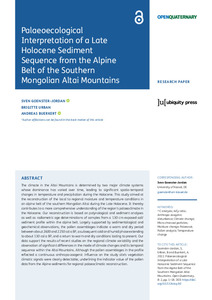Palaeoecological Interpretation of a Late Holocene Sediment Sequence from the Alpine Belt of the Southern Mongolian Altai Mountains
| dc.date.accessioned | 2022-05-30T09:46:03Z | |
| dc.date.available | 2022-05-30T09:46:03Z | |
| dc.date.issued | 2022-02-17 | |
| dc.identifier | doi:10.17170/kobra-202205176193 | |
| dc.identifier.uri | http://hdl.handle.net/123456789/13867 | |
| dc.description.sponsorship | Gefördert durch den Publikationsfonds der Universität Kassel | ger |
| dc.language.iso | eng | eng |
| dc.rights | Namensnennung 4.0 International | * |
| dc.rights.uri | http://creativecommons.org/licenses/by/4.0/ | * |
| dc.subject | ¹⁴C analysis | eng |
| dc.subject | A/Cy ratio | eng |
| dc.subject | anthropo-zoogenic disturbance | eng |
| dc.subject | climate change | eng |
| dc.subject | micro charcoal particles | eng |
| dc.subject | moisture change | eng |
| dc.subject | palaeosol | eng |
| dc.subject | pollen analysis | eng |
| dc.subject | temperature change | eng |
| dc.subject.ddc | 570 | |
| dc.title | Palaeoecological Interpretation of a Late Holocene Sediment Sequence from the Alpine Belt of the Southern Mongolian Altai Mountains | eng |
| dc.type | Aufsatz | |
| dcterms.abstract | The climate in the Altai Mountains is determined by two major climate systems whose dominance has varied over time, leading to significant spatio-temporal changes in temperature and precipitation during the Holocene. This study aimed at the reconstruction of the local to regional moisture and temperature conditions in an alpine belt of the southern Mongolian Altai during the Late Holocene. It thereby contributes to a more comprehensive understanding of the region’s palaeoclimate in the Holocene. Our reconstruction is based on palynological and sediment analyses as well as radiometric age determinations of samples from a 130 cm exposed soil/sediment profile within the alpine belt. Largely supported by sedimentological and geochemical observations, the pollen assemblages indicate a warm and dry period between about 2600 and 2250 cal a BP, a subsequent cold and humid phase extending to about 130 cal a BP, and a return to warm and dry conditions lasting to present. Our data support the results of recent studies on the regional climate variability and the observation of significant differences in the mode of climate changes and its temporal sequence within the Altai Mountains. Although the pollen assemblages in the profile reflected a continuous anthropo-zoogenic influence on the study site’s vegetation climatic signals were clearly detectable, underlining the indicator value of the pollen data from the Alpine sediments for regional palaeoclimatic reconstruction. | eng |
| dcterms.accessRights | open access | |
| dcterms.creator | Gönster-Jordan, Sven | |
| dcterms.creator | Urban, Brigitte | |
| dcterms.creator | Bürkert, Andreas | |
| dc.relation.doi | doi:10.5334/oq.90 | |
| dc.subject.swd | Altai | ger |
| dc.subject.swd | Kohlenstoff-14 | ger |
| dc.subject.swd | Klimaänderung | ger |
| dc.subject.swd | Holozän | ger |
| dc.subject.swd | Bodenfeuchte | ger |
| dc.subject.swd | Fossiler Boden | ger |
| dc.subject.swd | Pollenanalyse | ger |
| dc.subject.swd | Temperatur | ger |
| dc.type.version | publishedVersion | |
| dcterms.source.identifier | eissn:2055-298X | |
| dcterms.source.journal | Open Quaternary | eng |
| dcterms.source.volume | Volume 8 | |
| kup.iskup | false | |
| dcterms.source.articlenumber | 2 |
Dateien zu dieser Ressource
Das Dokument erscheint in:
-
Artikel [1106]


